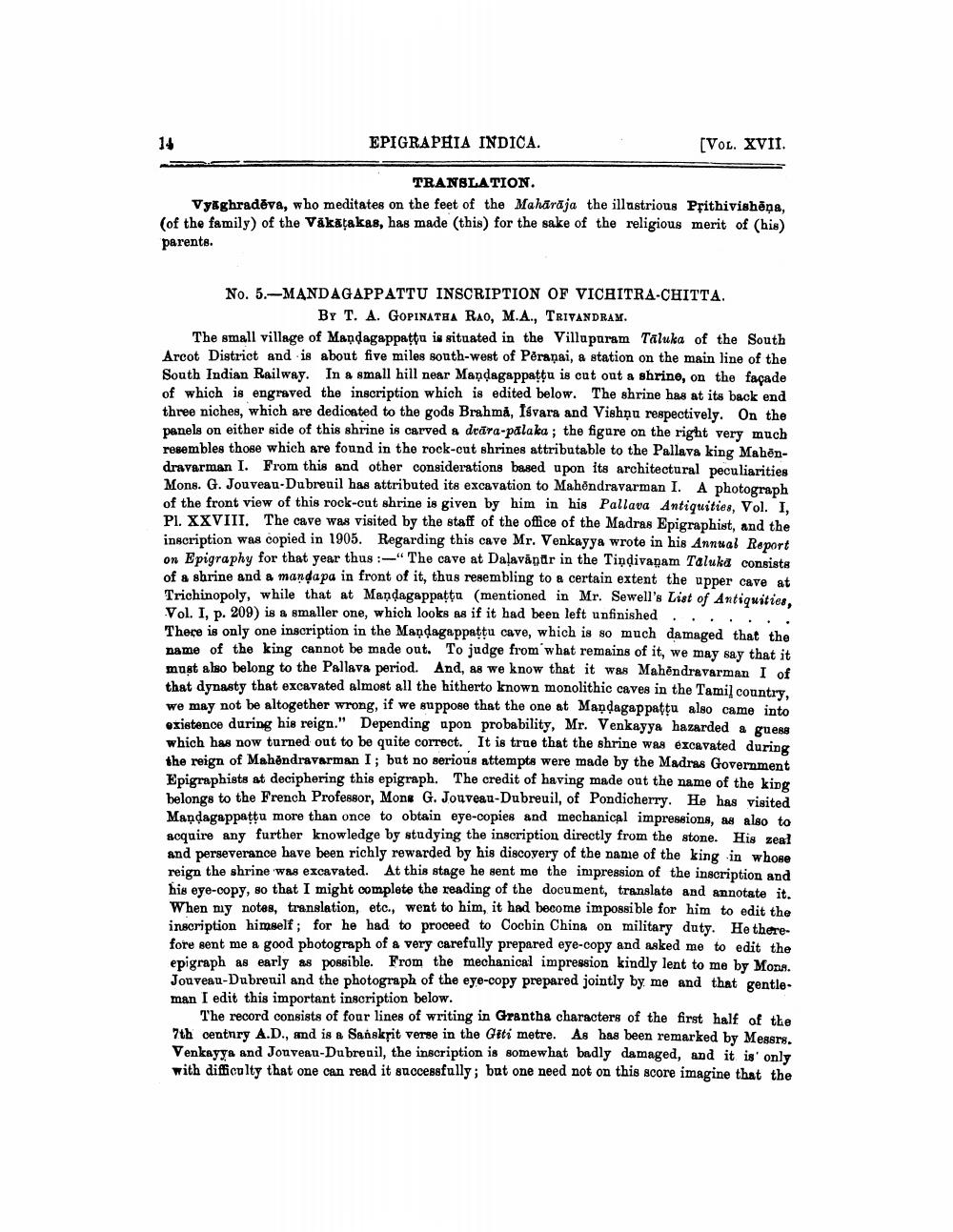________________
EPIGRAPHIA INDICA.
[VOL. XVII.
TRANSLATION Vy ghradēva, who meditates on the feet of the Maharaja the illustrious Prithivishona, (of the family) of the Vakatakas, has made (this) for the sake of the religious merit of (his) parente.
No. 5.-MANDAGAPPATTU INSCRIPTION OF VICHITRA-CHITTA.
BY T. A. GOPINATHA RAO, M.A., TRIVANDRAM. The small village of Mandagappatta is situated in the Villupuram Taluka of the South Arcot District and is about five miles south-west of Peraņai, a station on the main line of the South Indian Railway. In a small hill near Mandagappattu is cut out a shrine, on the facade of which is engraved the inscription which is edited below. The shrine has at its back end three niches, which are dedicated to the gods Brahmå, fávara and Vishņu respectively. On the panels on either side of this shrine is carved a deāra-palaka; the figure on the right very much resembles those which are found in the rock-cut shrines attributable to the Pallava king Mahondravarman I. From this and other considerations based upon its architectural peculiarities Mons. G. Jouveau-Dubreuil has attributed its excavation to Mahendravarman I. A photograph of the front view of this rock-cut shrine is given by him in his Pallava Antiquities, Vol. I, Pl. XXVIII. The cave was visited by the staff of the office of the Madras Epigraphist, and the inscription was copied in 1905. Regarding this cave Mr. Venkayya wrote in his Annual Report on Epigraphy for that year thus :-"The cave at Dalaväntir in the Tindivanam Taluka consists of a shrine and a mandapa in front of it, thus resembling to a certain extent the upper cave at Trichinopoly, while that at Mandagappattu (mentioned in Mr. Sewell's List of Antiquities, Vol. I, p. 209) is a smaller one, which looks as if it had been left unfinished....... There is only one inscription in the Mandagappattu cave, which is so much damaged that the name of the king cannot be made out. To judge from what remains of it, we may say that it must also belong to the Pallava period. And, as we know that it was Mahendravarman I of that dynasty that excavated almost all the hitherto known monolithic caves in the Tamil country, we may not be altogether wrong, if we suppose that the one at Mandagappattu also came into existence during his reign." Depending upon probability, Mr. Venkayya hazarded a guess which has now turned out to be quite correct. It is true that the shrine was excavated during the reign of Mahendravarman I; but no serious attempts were made by the Madras Government Epigraphists at deciphering this epigraph. The credit of having made out the name of the king belongs to the French Professor, Mons G. Jouveau-Dubreuil, of Pondicherry. He has visited Mandagappattu more than once to obtain eye-copies and mechanical impressions, and also to acquire any further knowledge by studying the inscription directly from the stone. His zeal and perseverance have been richly rewarded by his discovery of the name of the king in whose reign the shrine was excavated. At this stage he sent me the impression of the inscription and his eye-copy, so that I might complete the reading of the document, translate and annotate it. When my notes, translation, etc., went to him, it had become impossible for him to edit the inscription himself; for he had to proceed to Cocbin China on military duty. He therefore sent me a good photograph of a very carefully prepared eye-copy and asked me to edit the epigraph as early as possible. From the mechanical impression kindly lent to me by Mons. Jouveau-Dubreuil and the photograph of the eye-copy prepared jointly by me and that gentle man I edit this important inscription below.
The record consists of four lines of writing in Grantha characters of the first half of the 7th centnry A.D., and is a Sanskrit verse in the Giti metre. As has been remarked by Messrs. Venkayya and Jouveau-Dubreuil, the inscription is somewhat badly damaged, and it is only with difficulty that one can read it successfully; but one need not on this score imagine that the




